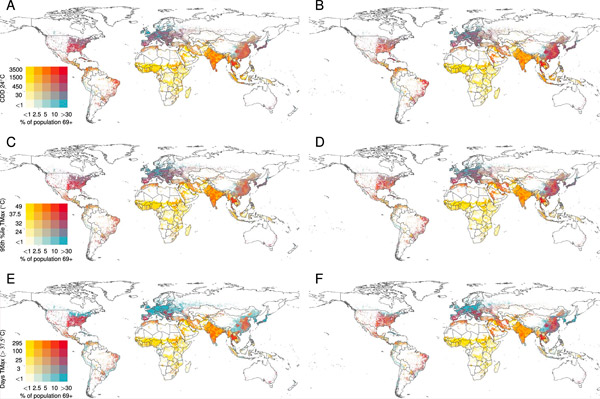
来自 CMCC 基金会(欧洲-地中海气候变化中心)的地球科学家和环保主义者团队与波士顿大学的两名同事一起发现证据表明,由于全球变暖和人口老龄化,到 2050 年全球可能有多达 2.46 亿人面临热应激的风险。
该团队在《自然通讯》杂志上发表的论文中描述了他们如何使用气候模型来估计全球热点并将其与同一地区的人口预测进行比较。
由于人类活动产生的温室气体排放,地球正在变暖。然而,地球并非所有地区都会出现同等程度的变暖——预计某些地区(例如非洲和亚洲部分地区)的温度会高于其他地区。
不幸的是,与此同时,60 岁以上的人口数量也在增长——预计到 2050 年,这一数字将翻一番,其中许多人生活在亚洲和非洲——这些国家很少配备空调。
在这项新研究中,研究小组指出,虽然已经进行了大量研究来更好地了解极端高温对老年人的影响,但很少有研究来弄清楚未来几年有多少老年人可能面临风险。为了找到答案,他们研究了2050年的气候和人口模型。
气候模型显示,未来30年,全球极端高温天数平均将增加约10天至20天。研究人员还发现,这些高温天数的增幅将取决于其发生的地区。

当前气候(左栏)和 2050 年左右 SSP2(45)(右栏)中全球衰老和热暴露的交集。
A、B. 69岁及以上人口年均暴露于降温度日数(CDD)的比例。C
、D. 对应于当地极端高温暴露第95百分位数(TMAX95)的年平均气温。E
、F. 每年TMAX > 37.5°C的天数。
来源:Nature Communications (2024). DOI: 10.1038/s41467-024-47197-5
人口统计模型显示,约有 23% 的 69 岁以上老人将生活在将经历危险高温的地区,而目前这一比例仅为 14%。
总体而言,研究小组发现,到 2050 年,1.77 亿至 2.46 亿 69 岁以上的人可能会生活在经常出现危险高温的地方,其中许多人面临与高温有关的疾病或死亡的风险。

